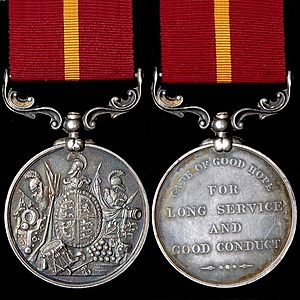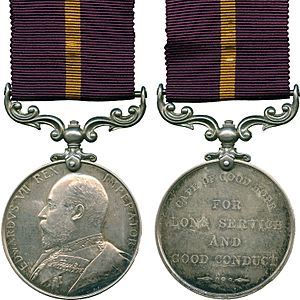Army Long Service and Good Conduct Medal (Cape of Good Hope) facts for kids
Quick facts for kids Army Long Service and Good Conduct Medal (Cape of Good Hope) |
|
|---|---|

Queen Victoria version
|
|
| Country | |
| Type | Military long service medal |
| Eligibility | Permanent Force Other Ranks |
| Awarded for | 18 years service and good conduct |
| Status | Discontinued in 1910 |
| Statistics | |
| Established | 1896 (Victoria) 1901 (Edward VII) |
| Order of wear | |
| Next (higher) | |
| Equivalent | |
| Next (lower) | |
Ribbon Bar |
|
The Army Long Service and Good Conduct Medal (Cape of Good Hope) was a special award given to soldiers in the Cape Colony (now part of South Africa). This medal was created in 1896. It was given to soldiers who served for a long time and showed good behavior. Queen Victoria, the Queen of the United Kingdom at the time, allowed different colonies to create their own versions of British military medals. The Cape of Good Hope decided to do this in 1895.
Contents
What is a Long Service Medal?
A long service medal is an award given to military members who have served for a certain number of years. It recognizes their dedication and good conduct. The original British Army Long Service and Good Conduct Medal was first created in 1830 by King William IV.
Changes Over Time
When Queen Victoria became Queen in 1837, the design of the medal changed. Later, when King Edward VII took the throne in 1901, his image was put on the medal. The ribbon for the British medal was plain red until 1917, when white stripes were added.
How Long to Serve?
At first, soldiers had to serve for 21 years in the infantry or 24 years in the cavalry to get the medal. But from 1870, this was changed. Soldiers only needed to complete 18 years of good service to receive the medal.
Cape Colonial Forces Explained
In the late 1800s, the military in the Cape Colony had different groups. There was a permanent police force called the Frontier Armed and Mounted Police. There were also two part-time groups, the Burgher Force and the Volunteer Force. These forces were set up in 1855. This happened after the United Kingdom gave the Cape of Good Hope some self-governance in 1853.
Creating the Cape Medal
On May 31, 1895, Queen Victoria gave permission for colonies to create their own versions of British military medals. The Cape of Good Hope started this system in September 1895. In 1896, they introduced the Army Long Service and Good Conduct Medal (Cape of Good Hope). This medal was just as important as the British version.
Other Colonies with Medals
Many other places also created their own medals. These included Canada, India, Natal, New Zealand, and several parts of Australia. After 1901, the whole Commonwealth of Australia also had its own version.
Different King, Same Medal
From 1901, a second version of the Cape medal was awarded. This one had the image of King Edward VII on the front. The back of the medal stayed the same for both versions. The front of both Cape medals looked just like the front of their British versions.
Who Received the Medal?
The Army Long Service and Good Conduct Medal (Cape of Good Hope) was given to non-commissioned officers and other soldiers. They had to complete eighteen years of perfect service in the Permanent Force. If a soldier later received the Meritorious Service Medal, they would stop wearing this long service medal.
How Medals are Worn
Medals are worn in a specific order. This order is set by the British Central Chancery of the Orders of Knighthood. The Army Long Service and Good Conduct Medal (Cape of Good Hope) was worn in the same place as the United Kingdom's Army Long Service and Good Conduct Medal. It was worn after the Accumulated Campaign Service Medal and before the Naval Long Service and Good Conduct Medal (1830).
South African Order of Wear
From April 6, 1952, South Africa started using its own medals. Older British medals could still be worn. However, they were worn after all the new South African medals. The only exception was the Victoria Cross, which always came first. The Army Long Service and Good Conduct Medal (Cape of Good Hope) was worn in this order:
- It was worn after the Meritorious Service Medal (South Africa).
- It was worn before the Army Long Service and Good Conduct Medal (Natal).
Medal Design
The medal was made of silver. It was a round disk, about 36 millimeters wide and 3 millimeters thick. It had a fancy hanger at the top that swiveled.
Front of the Medal (Obverse)
The Queen Victoria version of the medal had a design of weapons and a shield with the Royal Coat of Arms. It did not have any words. The King Edward VII version had the King's image and the words "EDWARDVS VII REX IMPERATOR" around the edge. Both versions had a raised edge.
Back of the Medal (Reverse)
The back of both medals was smooth with a raised edge. It had the words "CAPE OF GOOD HOPE" curved at the top. Below that, it said "FOR LONG SERVICE AND GOOD CONDUCT" in four straight lines. There were three dots and two spear blades underneath the words.
Ribbon Color
The ribbon for the Cape of Good Hope medal was 32 millimeters wide and crimson (a deep red color). It had a 4-millimeter wide yellow stripe in the middle. The British medal's ribbon was plain crimson until 1916.
When the Medal Stopped Being Awarded
The Cape of Good Hope and the Colony of Natal were two of the four colonies that formed the Union of South Africa in 1910. When the Union was created, these special colonial medals were no longer given out. Instead, a new medal called the Permanent Forces of the Empire Beyond the Seas Medal was created in 1910. This new medal was a single award for long service and good conduct for all permanent forces in the Dominions and Colonies.





